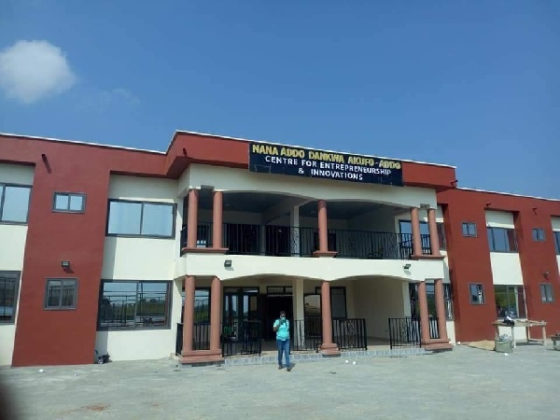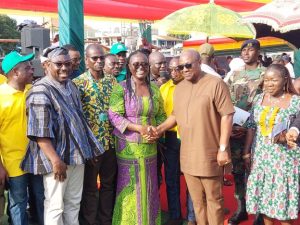All is set for President Nana Addo Dankwa Akufo-Addo to commission some 75 Greenhouses and Entrepreneurship Innovative Centre at Dawhenya Irrigation site today, but The Herald’s information is that, what is meant to look like an initiative of the present government, is far from the truth.
Electronic fliers, have been sent out on the internet and adverts have been published in the Daily Graphic Newspaper, all in the midst of the fanfare, but The Herald’s investigation, has established that this project was done under the Mahama administration, but was rundown after the workers were sacked from site, when the Akufo-Addo government took office in 2017.
The project, which was under the Youth Enterprise Support (YES) at the Dahwenya Irrigation Greenhouse Enclave, had 100-hectares dedicated to lead the country’s greenhouse revolution.
Indeed, the then Chief Executive of YES, Helga Boadi, was captured by Daily Graphic online in an article written by Seth J. Bokpe and published on February 27, 2017, expressing optimism about more young people being trained to lead greenhouse vegetable production in Ghana.
Interestingly, YES, has since become National Entrepreneurship and Innovation Programme (NEIP) and led by Lawyer John Ampontuah Kumah, and he has advertised same project he inherited on the official website of the institution, saying “the NEIP Greenhouse Estate Project is the largest Greenhouse Estate in Africa. Currently we have installed 75 greenhouse domes at the Dawhenya irrigation site in the Greater Accra Region”.
Mr Kumah, has also named the place after the President; Nana Addo Dankwa Akufo-Addo Centre for Entrepreneurship & Innovations”.
When reached, Helga Boadi, confirmed her administration started the greenhouse project with the procurement of 74 greenhouses and one nursery on land acquired at the GIDA in Dawhenya.
YES was then in discussion with the Office of President to have ex-President John Maham commission it, but this was not done before the NDC was voted out of power, leading to the change in government in January 2017.
She declined to give further information on the project.
In April 2016, YES contracted Enviro Dome UG, a Ghanaian company to procure and install 74 greenhouses and one nursery on land acquired at the GIDA in Dawhenya.
Installation of these greenhouse units commenced in June 2016 and by February 2017 at least 20 of them were in full operation, whilst the installation of the remaining units was ongoing.
It’s worthy to note that, YES handed over a total of 75 greenhouse (at various stages of installation) units to the new administration in May 2017.
Below, is the Daily Graphic publication on the project entitled “Greenhouse revolution to attract youth into agriculture”.
It’s a large tract of land dotted with swathes of green rice fields and heavy with weeds. A long dusty, snaky road split the fields but it is vehicle-friendly.
But in the belly of the wild and rice fields, greenhouses are springing up-the Dahwenya Irrigation Greenhouse Enclave where 100-hectares have been dedicated to lead the country’s greenhouse revolution.
This is where the Youth Enterprise Support (YES) is hopeful locally grown vegetables will be cultivated which will be showing up on the plates of residents of Accra more often from this year, as it begins a ground-breaking greenhouse project.
It is also where the Chief Executive of YES, Mrs Helga Boadi, is optimistic more young people would be trained to lead greenhouse vegetable production in Ghana.
Among the vegetables to be cultivated are different varieties of cucumbers, melons, tomatoes and capsicum (sweet pepper).
The state start-up financier is establishing the 75-unit greenhouse agriculture estate as an incubator to train young people and a hub for vegetable production to feed Accra, where urban agriculture is a drop in the ocean.
When completed, the YES Greenhouse Village will occupy a five-hectare land with 74 greenhouses and a nursery where seeds would be nursed and transplanted. It would be West Africa’s largest.
The greenhouses are expected to be completed in June before the project takes off.
Even before the first commercial harvest begins, MrsBoadi said there was already an off-taker who imports six forty-footer containers of vegetable into the country, and was willing to buy every single vegetable cultivated in the village.
A pilot of the farm is already yielding fruits with the harvest of cucumber, tomatoes and capsicum (green pepper).
What is greenhouse?
A greenhouse is a dome or square like structure that allows a farmer to grow crops, especially vegetables-including tomato, sweet pepper, strawberry, broccoli, cauliflower cucumber, green beans-in a controlled environment.
In the greenhouse, the farmer controls the elements of production under partial or fully controlled environmental conditions to get optimum growth and productivity.
The key elements which the farmer may control include the greenhouse temperature, the amount of light, the system of irrigation (drip or rain gun, or sprinkle), fertiliser application and the atmospheric humidity.
In greenhouses, the farmer can plant all-year-round under high intensive cultivation.
“Some of these vegetables are expensive in our supermarkets. When we start growing it here, the prices will come down because we are not importing and paying duties.
“Further down the line, we will add exotic vegetables, including butternut squash. But for now, we want to cultivate the main staple and push them out for people to know that we have the capacity to cultivate and supply,” she said.
MrsBoadi said the project would be self-sustaining and would serve as a means for YES to depend less on government.
The YES boss also believes that the balance sheet also looks good for the project, with an estimated 357 tonnes of vegetables for GH?1,785,000 every season (three months). The projection is based on planting tomatoes in all 75 units.
How it will run
The projector will be a greenhouse incubator where the selected farmers would be trained to operate their own facility in the village.
“Ideally, we give out loans for the beneficiaries, they work and pay back, but the young farmer would be here for a maximum of two years, where they would receive a hands-on growing experience, so they could understand everything from seed to harvesting,” MrsBoadi explained.
She was, however, quick to add that for those showing exceptional performance would be allocated a greenhouse before their training period ends.
“When you are allocated the greenhouse, you will still be part of the village because we already have an off-taker agreement; it is not just about you receiving a greenhouse and moving out. You can move out if you want, but we are more concerned about these young people making money for themselves through agriculture. This village provides them with the base and structure to benefit from the management and off-taker. The money that comes from your greenhouse is yours, less production cost.”
“We are trying to let young people know that farming is cool and agriculture is a revolution that we want to lead,” she said.
When the Daily Graphic visited the site last Thursday, workers on site were busily setting up some of the greenhouses.
A walk through
Inside, the greenhouse is much cooler than the sticky mid-morning heat outside.
One of the facilities was filled with neat rows of giant tomato plants, flowering and bearing fruits. Held up by strings that hang from the roof of the greenhouse, each plant is estimated to produce at least five to 10 kilogrammes, twice what an open farm could yield.
Neat rows of capsicum (green pepper) were in another greenhouse, ready for harvest. Cucumber had also been successfully harvested.
A loop irrigation (pipe) system runs through long plastic containers filled with coconut pith. Each loop is connected to a water reservoir and a fertiliser container. The system delivers just enough water and fertiliser in equal quantities to each plant.
No soil
Here, soil is not used but rather a growing medium known as coconut pith which is enriched with the required nutrients for the plants.
The Manager of the Greenhouse EnviroDome Ltd (TGEL), the company constructing greenhouses, Mr Lord Kuleape, explained that the pith was preferable because “there may be micro-organisms in the soil which could impede plant growth and unforeseen nutrient that may be too much for the plant.
“In the end, the plant may be in a greenhouse but won’t be doing well. You may end up with additional cost in soil analysis and soil treatment which is much more expensive. The coconut pith is inert,” he said.
He was, however, quick to add that compost could be used but the source must be clean.
Giving thumbs up to greenhouse technology, he said “the advantage of a greenhouse is that you are able to regulate the temperature, control the soil and water. In the lean period when there is no water, you can grow okra, tomato and other vegetable. It is not a rain-fed system. It is more scientific,” he added.
Challenges & solutions
Apart from temperature and humidity, loss of soil fertility, lack of quality water sources, greenhouse critics say pests and disease are also a headache for its farmers.
But MrKuleape said good hygiene was the solution.
“In the EnviroDome greenhouse, we do regular insect check with insect sticky traps. Regular sanitation and good cultural agricultural practices will deal with that (controlled temperature and humidity). It also has a disinfectant to wash your feet and sanitiser to clean your hands so one does not carry any disease inside.
“This is why it’s imperative we train people before they start using the system to understand the core principles of it. A healthy and a clean greenhouse should be devoid of such challenges when the appropriate fumigation is done timely in and around the greenhouse,” MrKuleape added.
This story was published by The Herald newspaper before the commissioning of the greenhouses.
[embedyt] https://www.youtube.com/watch?v=j648gHdv94Y[/embedyt]








